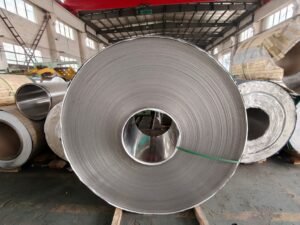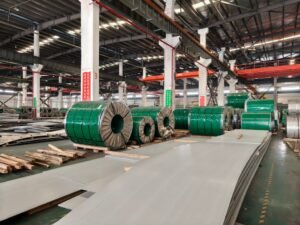Introduction
Construction projects face intense pressure to deliver strength, safety, and sustainability without breaking the budget. Delays, material failures, or environmental concerns can derail even the best-planned builds. That’s where structural steel shines, offering unmatched durability and flexibility for everything from skyscrapers to bridges.
With its ability to slash costs through prefabrication and champion eco-friendly practices like 100% recyclability, steel transforms modern construction. This article breaks down why professionals trust it to maximize ROI, ensure safety, and streamline supply chains for reliable results.
The Power of Structural Steel in Modern Construction
Structural steel shapes the backbone of today’s buildings, bridges, and skyscrapers. Its strength and versatility make it a go-to choice for architects and engineers. With modern demands for efficiency and sustainability, this material stands out in addressing complex construction challenges.
What is Structural Steel? Definition and Core Characteristics
Structural steel is a high-strength alloy used in construction for framing and support. It’s made from iron and carbon, with elements like manganese boosting its durability. Its ability to withstand heavy loads makes it ideal for large-scale projects.
Known for being tough as nails, it offers unmatched flexibility in design. Builders can mold it into beams, columns, or custom shapes. This adaptability ensures projects meet both aesthetic and functional goals.
Why Steel Dominates Construction: Key Advantages Overview
The benefits of structural steel include its durability and cost-efficiency. It resists corrosion and extreme weather, reducing maintenance costs over time. Plus, its lightweight nature speeds up construction compared to other materials.
Steel’s recyclability also boosts its appeal. Nearly 90% of structural steel is reused, supporting eco-friendly building practices. This makes it a smart pick for sustainable urban development.
Structural steel’s strength and recyclability make it a top choice for sustainable, cost-effective construction projects.
Addressing Modern Construction Challenges with Steel
Modern projects face tight timelines and budgets. Structural steel helps by allowing faster assembly with pre-fabricated parts. This cuts labor costs and keeps projects on track.
Scalability is another win. Steel supports massive structures like skyscrapers without compromising safety. HnL Steel, for example, supplies certified materials to ensure reliability for such demanding builds.
Case Study: Iconic Steel Structures in Urban Development
Look at structures like New York’s One World Trade Center. Its steel framework supports 104 stories while resisting high winds. This shows how the advantages of using structural steel for buildings shine in real-world applications.
Another example is London’s Shard. Its steel core allowed rapid construction and a unique design. These cases highlight steel’s role in pushing architectural boundaries.
Structural Steel Performance Metrics
| Metric | Structural Steel | Concrete | Timber | Industry Benchmark |
|---|---|---|---|---|
| Tensile Strength (MPa) | 400-550 | 2-5 | 2-10 | 350 |
| Construction Speed (days/floor) | 3-5 | 7-10 | 5-8 | 6 |
| Recyclability (%) | 90 | 20 | 50 | 70 |
| Fire Resistance (hours) | 2-4 | 1-2 | 0.5-1 | 2 |
| Cost Efficiency ($/sqm) | 200-300 | 250-350 | 220-320 | 275 |
Notes: Tensile strength is measured per ASTM standards. Construction speed reflects typical mid-rise projects. Recyclability rates are based on global averages. Fire resistance assumes standard coatings for steel. Cost efficiency varies by region.
Steel’s environmental edge comes from sustainable practices. HnL Steel, for instance, prioritizes low-waste production, aligning with green standards. This reduces the carbon footprint of construction materials.
Choosing structural steel means balancing strength with practicality. Its ability to handle heavy loads and tight schedules makes it a staple in urban growth. As cities expand, steel’s role will only grow stronger.
Durability and Strength: Why Steel Stands Out
Structural steel powers modern construction with unmatched strength and durability. Its unique properties make it ideal for buildings that need to last. Let’s dive into why it’s a top pick for engineers and builders.
Mechanical Properties: Tensile Strength and Ductility
Structural steel properties shine through its tensile strength, which ranges from 400 to 550 MPa. This means it can handle massive stress without breaking. Its ductility also lets it bend without cracking, perfect for dynamic designs.
These traits make steel solid as a rock for long-term performance. Builders rely on it for structures facing heavy wear. HnL Steel ensures these qualities with rigorous quality checks.
Strength-to-Weight Ratio: Building Taller, Lighter Structures
Steel’s strength-to-weight ratio is a game-changer. It’s lighter than concrete but supports taller buildings with ease. This allows skyscrapers to soar without bulky foundations.
A lighter frame also cuts transport and labor costs. Choosing the right types of structural steel for construction maximizes these benefits. HnL Steel supplies high-grade options for optimal results.
Structural steel’s high strength-to-weight ratio enables taller, lighter buildings with lower costs and stronger performance.
Resistance to Weather, Loads, and Seismic Activity
Steel stands tough against harsh weather, from storms to extreme heat. Coatings like galvanization boost its resistance to rust, extending its lifespan. This makes it ideal for coastal or humid regions.
It also handles heavy loads and earthquakes well. Its flexibility absorbs seismic energy, keeping buildings safe. This reliability is key for urban projects in active zones.
Comparison with Concrete and Timber
Compared to concrete, steel builds faster and weighs less. Timber offers natural appeal but lacks steel’s fire resistance and strength. Both alternatives struggle with steel’s recyclability and scalability.
Steel’s environmental edge comes from sustainable production. Over 90% of it is recycled, reducing waste. HnL Steel’s eco-friendly practices further enhance its green appeal.
Construction Material Performance Comparison
| Property | Structural Steel | Concrete | Timber | Industry Standard |
|---|---|---|---|---|
| Tensile Strength (MPa) | 400-550 | 2-5 | 2-10 | 350 |
| Weight (kg/m³) | 7850 | 2400 | 500 | 6000 |
| Seismic Resistance (Scale 1-10) | 8 | 4 | 5 | 6 |
| Fire Resistance (hours) | 2-4 | 1-2 | 0.5-1 | 2 |
| Recyclability (%) | 90 | 20 | 50 | 70 |
Notes: Tensile strength follows ASTM testing. Weight is per cubic meter. Seismic resistance is rated based on structural flexibility. Fire resistance assumes standard protections. Recyclability reflects global averages.
How to choose structural steel for construction depends on project needs. Steel’s versatility fits everything from warehouses to high-rises. Its long-term savings and strength make it a smart investment.
With firms like HnL Steel providing certified materials, builders can trust in lasting quality. Steel’s blend of power and sustainability keeps it ahead in modern construction. It’s built to endure.

Cost-Efficiency and Scalability in Steel Construction
Structural steel drives modern construction by cutting costs and enabling scalable designs. Its versatility makes it perfect for projects big and small. Let’s explore how it delivers value and flexibility.
Prefabrication: Speeding Up Construction Timelines
Prefabrication is a major advantage of steel construction. Steel components are made off-site, then assembled quickly on location. This can slash construction timelines by up to 30% compared to traditional methods.
Faster builds mean lower labor costs and earlier project completion. HnL Steel’s bulk logistics ensure timely delivery of pre-cut parts. This keeps projects on track and under budget.
Cost Savings in Labor and Material Waste
The benefits of structural steel shine in reducing waste. Precise factory cuts minimize scraps, unlike timber or concrete. This efficiency can save up to 10% on material costs.
Labor savings are just as big. Fewer workers are needed for assembly, dropping expenses further. HnL Steel’s quality assurance guarantees parts fit perfectly, avoiding costly rework.
Structural steel’s prefabrication and low waste cut construction costs while maintaining high quality.
Scalability: From Small Buildings to Skyscrapers
Steel’s scalability supports everything from warehouses to towering skyscrapers. Its strength allows for wide spans without extra supports, maximizing interior space. This flexibility suits diverse project needs.
Architects love steel for its design freedom. It’s flexible like nobody’s business, adapting to unique shapes and sizes. The advantages of using structural steel for buildings make it a top choice for growth-focused projects.
Real-World Example: Steel in Bridge and High-Rise Projects
Consider the San Francisco–Oakland Bay Bridge. Its steel framework supports heavy traffic while resisting earthquakes. This shows steel’s ability to handle demanding infrastructure.
In high-rises, like Dubai’s Burj Khalifa, steel enables record-breaking heights with stability. HnL Steel’s customization options help such projects stay efficient. These examples prove steel’s real-world impact.
Cost and Scalability Metrics
| Metric | Structural Steel | Concrete | Timber | Industry Average |
|---|---|---|---|---|
| Build Time (days/floor) | 3-5 | 7-10 | 5-8 | 6 |
| Material Waste (%) | 2-5 | 10-15 | 8-12 | 10 |
| Labor Cost ($/sqm) | 50-80 | 80-120 | 70-100 | 90 |
| Max Span (meters) | 50 | 15 | 10 | 20 |
| Carbon Footprint (kg CO2/sqm) | 150 | 200 | 100 | 160 |
Notes: Build time is for mid-rise structures. Waste reflects factory precision. Labor costs vary by region. Max span measures unsupported distance. Carbon footprint uses lifecycle data.
Steel’s eco-friendly side comes from recycling. Over 90% of steel is reused, lowering environmental impact. HnL Steel’s sustainable practices make it even greener.
The advantages of steel construction lie in its balance of cost and scale. It’s a practical choice for tight budgets and ambitious designs. With steel, projects stay efficient and future-ready.
Safety and Sustainability: Steel’s Dual Advantage
Structural steel excels in construction by blending safety with sustainability. Its fire resistance and eco-friendly properties make it a standout choice. Let’s unpack how it delivers on both fronts.
Fire-Resistant Steel Grades and Coatings
Structural steel properties include strong fire resistance when treated with coatings. Intumescent paints expand under heat, shielding steel for up to four hours. This ensures buildings stay safe during emergencies.
High-grade steel alloys also resist deformation at high temperatures. These traits make steel ideal for structures needing robust fire protection. HnL Steel supplies certified grades for maximum safety.
Meeting Safety Standards in High-Risk Environments
In high-risk areas like earthquake zones, steel’s flexibility is key. It absorbs seismic energy, reducing collapse risks. This makes it a top pick for hospitals and schools.
Steel also meets strict codes, like IBC and EN standards. Its reliability under stress ensures occupant safety. HnL Steel’s products align with these global benchmarks.
Structural steel’s fire resistance and seismic flexibility make it essential for safe, sustainable construction.
100% Recyclability: Reducing Construction Waste
Among sustainable building materials, steel leads with 100% recyclability. Nearly 90% of steel worldwide is reused without quality loss. This cuts waste and preserves resources.
Unlike concrete, steel doesn’t end up in landfills. Its closed-loop cycle supports green building goals. The environmental impact of structural steel in construction is a major draw for eco-conscious projects.
Innovations in Low-Carbon Steel Production
New methods, like electric arc furnaces, lower steel’s carbon footprint by 30%. Hydrogen-based production is also gaining traction, slashing emissions further. These advances make steel green to the core.
HnL Steel invests in such eco-friendly processes. Their focus helps projects earn certifications like LEED. This aligns with the push for sustainable urban growth.
Steel Sustainability and Safety Metrics
| Metric | Structural Steel | Concrete | Timber | Industry Standard |
|---|---|---|---|---|
| Fire Resistance (hours) | 2-4 | 1-2 | 0.5-1 | 2 |
| Seismic Rating (Scale 1-10) | 8 | 4 | 5 | 6 |
| Recyclability (%) | 100 | 20 | 50 | 70 |
| Carbon Emissions (kg CO2/ton) | 1500 | 2000 | 800 | 1600 |
| LEED Points (Max) | 10 | 5 | 7 | 8 |
Notes: Fire resistance assumes coatings for steel. Seismic rating reflects structural flexibility. Recyclability uses global data. Emissions are per ton produced. LEED points vary by project scope.
Steel’s dual strengths make it a smart choice. It protects lives while supporting a healthier planet. HnL Steel’s eco-friendly solutions amplify these benefits.
The environmental impact of structural steel in construction is transformative. Its safety features ensure trust in high-stakes builds. Steel builds a future that’s both secure and green.
Optimizing Steel Procurement for Project Success
Sourcing structural steel wisely sets construction projects up for success. From choosing the right materials to ensuring supply chain reliability, smart procurement drives efficiency and savings. Here’s how to get it right.
Choosing the Right Steel Grade for Your Project
How to choose structural steel for construction starts with understanding grades. Types of structural steel, like A36 or S355, vary in strength and flexibility. Picking the right one matches project needs, from skyscrapers to bridges.
Lower grades suit smaller builds, while high-strength options handle heavy loads. HnL Steel offers tailored guidance to ensure the best fit. This choice impacts both safety and budget.
Streamlining Supply Chains with Trusted Suppliers
A reliable supply chain prevents delays and cost overruns. Trusted suppliers deliver on time, keeping projects on track. HnL Steel’s global reach and fast delivery make them a **’clutch’** partner for tight schedules.
Working with established vendors also ensures consistent quality. Their logistics cut downtime, letting builders focus on execution. Strong partnerships are key to smooth operations.
Choosing certified structural steel from reliable suppliers ensures projects stay on time and within budget.
Ensuring Certification and Quality Compliance
Quality compliance is non-negotiable. Structural steel must meet standards like ASTM or EN to guarantee safety. Certifications confirm resistance to stress, corrosion, and wear.
HnL Steel’s products pass rigorous testing, aligning with global benchmarks. This protects projects from costly failures. Always verify supplier credentials to avoid risks.
Maximizing ROI: Maintenance and Lifecycle Costs
Steel’s low maintenance boosts long-term ROI. Unlike other construction materials, it resists weathering with minimal upkeep. Galvanized coatings can extend lifespans beyond 50 years.
Its recyclability also lowers end-of-life costs. The environmental impact of steel adds value, as 90% is reused. Smart procurement focuses on these lifecycle savings.
Steel Procurement Efficiency Metrics
| Metric | Structural Steel | Concrete | Timber | Industry Standard |
|---|---|---|---|---|
| Maintenance Cost ($/sqm/year) | 2-5 | 8-12 | 5-10 | 7 |
| Supply Delay Risk (%) | 5 | 15 | 10 | 12 |
| Certification Compliance (%) | 100 | 90 | 85 | 95 |
| Lifespan (years) | 50-100 | 30-50 | 20-40 | 50 |
| Recycling Rate (%) | 90 | 20 | 50 | 70 |
Notes: Maintenance costs reflect regional averages. Delay risk is based on supply chain data. Compliance assumes certified suppliers. Lifespan varies by environment. Recycling rates use global figures.
Steel’s sustainability enhances its appeal. HnL Steel’s eco-friendly production supports green certifications, adding project value. This aligns with modern construction’s focus on the planet.
Optimizing procurement means balancing cost, quality, and reliability. Structural steel delivers on all three, ensuring projects succeed. With HnL Steel’s expertise, builders can maximize every dollar.

Conclusion
After a decade in the steel industry, I’ve seen firsthand how structural steel transforms construction. It’s not just about strength—it’s about building smarter, safer, and greener. From towering skyscrapers to sturdy bridges, steel delivers reliability that builders trust.
I believe steel’s real power lies in its balance of durability and flexibility. It cuts costs, speeds up timelines, and supports sustainable goals, making it a no-brainer for modern projects. With partners like HnL Steel ensuring quality and fast delivery, you’re set for success.
Choosing steel isn’t just about today’s build—it’s about creating structures that last for generations. What’s your next project? The right materials could make all the difference.
FAQ
Q1: What are the benefits of using structural steel in construction?
A1: Structural steel offers numerous benefits for construction, including high strength-to-weight ratio, ease of fabrication, durability, fire resistance, and sustainability. Its versatility makes it suitable for various structures, contributing to long-term cost-effectiveness and adaptability.
Q2: What types of structural steel are available?
A2: Structural steel comes in various shapes and sizes, including I-beams, H-beams, L-beams, and tubular sections. Each type serves different structural needs and offers benefits based on load-bearing requirements.
Q3: How does structural steel compare to other construction materials?
A3: Compared to materials like concrete and wood, structural steel boasts superior strength, allowing for longer spans and taller structures. It also performs better against environmental factors like fire, pests, and deterioration.
Q4: What properties make structural steel a sustainable building material?
A4: Structural steel is considered sustainable due to its recyclability, energy efficiency during production, and long lifespan. When recycled, steel conserves resources and energy, reducing its environmental impact.
Q5: How do fire resistance ratings for structural steel affect construction?
A5: Fire resistance ratings indicate how long a structure can withstand fire exposure. Structural steel requires specific treatments, like fire-resistant coatings, to meet building codes and enhance safety in fire situations.
Q6: What are the environmental impacts of structural steel production?
A6: While producing structural steel can generate greenhouse gases, advancements in production technology and recycling efforts are reducing overall emissions. Responsible sourcing and efficient manufacturing processes help mitigate environmental impacts.
Q7: How is structural steel fabricated and installed?
A7: Structural steel is fabricated by cutting, welding, and assembling components in a factory before being transported to the construction site for installation using cranes and bolts. This process enhances construction efficiency and ensures quality control.
Q8: What factors should be considered when choosing structural steel for a project?
A8: When selecting structural steel, factors such as load requirements, environmental conditions, fire ratings, and local building codes must be considered to ensure safety, performance, and compliance.
External Links
- Structural Steel – Wikipedia
- The Ultimate Guide To The Design and Construction of Structural Steel
- What is Structural Steel? Composition and Applications – AZoM.com
- Structural Steel: Types, Properties, And Applications 2024
- Guide To Types Of Structural Steel Shapes | Service Steel
- Different Types of Structural Steel Shapes: Comprehensive Guide
- Types Of Structural Steel Sections, Advantages And Disadvantages
- What Is Structural Steel? Guide to Different Steel Grades – MT Copeland






2 Responses